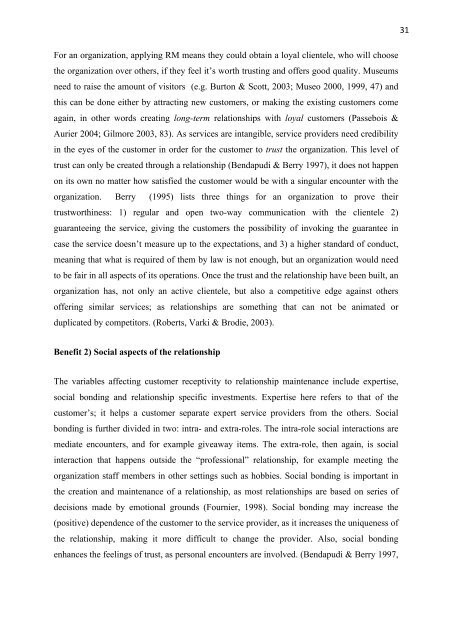Is there more to it than posting a status update?
Is there more to it than posting a status update?
Is there more to it than posting a status update?
Create successful ePaper yourself
Turn your PDF publications into a flip-book with our unique Google optimized e-Paper software.
For an organization, applying RM means they could obtain a loyal clientele, who will choose<br />
the organization over others, if they feel <strong>it</strong>’s worth trusting and offers good qual<strong>it</strong>y. Museums<br />
need <strong>to</strong> raise the amount of visi<strong>to</strong>rs (e.g. Bur<strong>to</strong>n & Scott, 2003; Museo 2000, 1999, 47) and<br />
this can be done e<strong>it</strong>her by attracting new cus<strong>to</strong>mers, or making the existing cus<strong>to</strong>mers come<br />
again, in other words creating long-term relationships w<strong>it</strong>h loyal cus<strong>to</strong>mers (Passebois &<br />
Aurier 2004; Gil<strong>more</strong> 2003, 83). As services are intangible, service providers need credibil<strong>it</strong>y<br />
in the eyes of the cus<strong>to</strong>mer in order for the cus<strong>to</strong>mer <strong>to</strong> trust the organization. This level of<br />
trust can only be created through a relationship (Bendapudi & Berry 1997), <strong>it</strong> does not happen<br />
on <strong>it</strong>s own no matter how satisfied the cus<strong>to</strong>mer would be w<strong>it</strong>h a singular encounter w<strong>it</strong>h the<br />
organization. Berry (1995) lists three things for an organization <strong>to</strong> prove their<br />
trustworthiness: 1) regular and open two-way communication w<strong>it</strong>h the clientele 2)<br />
guaranteeing the service, giving the cus<strong>to</strong>mers the possibil<strong>it</strong>y of invoking the guarantee in<br />
case the service doesn’t measure up <strong>to</strong> the expectations, and 3) a higher standard of conduct,<br />
meaning that what is required of them by law is not enough, but an organization would need<br />
<strong>to</strong> be fair in all aspects of <strong>it</strong>s operations. Once the trust and the relationship have been built, an<br />
organization has, not only an active clientele, but also a compet<strong>it</strong>ive edge against others<br />
offering similar services; as relationships are something that can not be animated or<br />
duplicated by competi<strong>to</strong>rs. (Roberts, Varki & Brodie, 2003).<br />
Benef<strong>it</strong> 2) Social aspects of the relationship<br />
The variables affecting cus<strong>to</strong>mer receptiv<strong>it</strong>y <strong>to</strong> relationship maintenance include expertise,<br />
social bonding and relationship specific investments. Expertise here refers <strong>to</strong> that of the<br />
cus<strong>to</strong>mer’s; <strong>it</strong> helps a cus<strong>to</strong>mer separate expert service providers from the others. Social<br />
bonding is further divided in two: intra- and extra-roles. The intra-role social interactions are<br />
mediate encounters, and for example giveaway <strong>it</strong>ems. The extra-role, then again, is social<br />
interaction that happens outside the “professional” relationship, for example meeting the<br />
organization staff members in other settings such as hobbies. Social bonding is important in<br />
the creation and maintenance of a relationship, as most relationships are based on series of<br />
decisions made by emotional grounds (Fournier, 1998). Social bonding may increase the<br />
(pos<strong>it</strong>ive) dependence of the cus<strong>to</strong>mer <strong>to</strong> the service provider, as <strong>it</strong> increases the uniqueness of<br />
the relationship, making <strong>it</strong> <strong>more</strong> difficult <strong>to</strong> change the provider. Also, social bonding<br />
enhances the feelings of trust, as personal encounters are involved. (Bendapudi & Berry 1997,<br />
31















